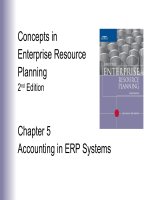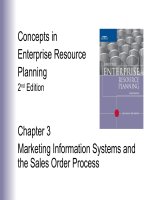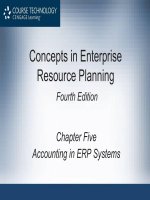A STAKEHOLDER PERSPECTIVE OF ENTERPRISE SYSTEMS IMPLEMENTATION a CASE STUDY OF a UNIVERSITYS ENTERPRISE RESOURCE PLANNING PROJECT
Bạn đang xem bản rút gọn của tài liệu. Xem và tải ngay bản đầy đủ của tài liệu tại đây (856.48 KB, 182 trang )
A Stakeholder Perspective of ES Implementation
A STAKEHOLDER PERSPECTIVE OF ENTERPRISE
SYSTEMS IMPLEMENTATION:
A CASE STUDY OF A UNIVERSITY’S ENTERPRISE
RESOURCE PLANNING PROJECT
SATHISH S/O SRITHARAN
(B. Comp., Information Systems, NUS)
A THESIS SUBMITTED
FOR THE DEGREE OF MASTER OF SCIENCE
DEPARTMENT OF INFORMATION SYSTEMS
NATIONAL UNIVERSITY OF SINGAPORE
2004
Sathish Page i
A Stakeholder Perspective of ES Implementation
Acknowledgements
The completion of this MSc. thesis is the culmination of a long and eventful journey.
This was a journey that I strongly feel I would never have completed on my own. With
that in mind, I would like to take this opportunity to express my heartfelt gratitude to a
few special people, without whom this thesis would not have been possible.
First and foremost, I would like to thank my supervisors, Prof. K. S. Raman and Dr. Pan
Shan Ling. Thank you for your help. Thank you for your support. Thank you for
believing in me when others, and sometimes even myself, didn’t. You have taught me so
much in the time we’ve spent together, and because of you, I have not only become a
better person, but more importantly, I have finally found my way in life.
Next, I would like to thank my fellow research colleagues. People like Paul, Mamata,
Calvin, Chee Wee, and so many others. Not only have you been a sounding board for me,
but more importantly, your dedication and passion for your work has truly inspired me to
aspire to reach greater heights in both academia and teaching.
I would also like to thank my gatekeeper and the rest of the project team in my case study
site. You have opened your doors to me, and done your utmost to facilitate my study, and
for that I am forever grateful.
Sathish Page ii
A Stakeholder Perspective of ES Implementation
To my family, who has endured my erratic hours and behavior, I thank you for your love
and your support. Without you, I would not be where I am today.
Finally, to my fiancée. You have stood beside me through thick and thin, and your love
has been my anchor during this time. Thank you.
Sathish Page iii
A Stakeholder Perspective of ES Implementation
Table of Contents
Title …………………………………………………………………… i
Acknowledgements ……………………………………………………… ii
Table of Contents ………………………………………………………. iv
List of Tables ……………………………………………………… …. ix
List of Figures ………………………………………………………… x
Executive Summary ……………………………………………………. xi
Chapter 1: Introduction ………………………………………………… 1
1.1. Research Background …………………………………………………………. 1
1.2. Research Questions …………………………………………………………… 4
1.3. Expected Contributions ……………………………………………………… 4
1.4. Organization of Thesis ………………………………………………………… 5
Chapter 2: Literature Review ………………………………………… 6
2.1. Enterprise Systems …………………………………………………………… 6
2.1.1. Introduction to Enterprise Systems …………………………………… 6
2.1.2. Features of Enterprise Systems ……………………………………… 10
2.1.2.1. Use of External Vendors ……………………………………… 12
2.1.2.2. Best Practices ……………………………………….………… 13
2.1.2.3. Potential for Integration ………………………………………… 15
2.1.2.4. Evolving Nature of Enterprise Systems ………………………… 16
2.1.2.5. Modular and Flexible …………………………………………… 18
Sathish Page iv
A Stakeholder Perspective of ES Implementation
2.1.2.6. Summary ……………………………………………………… 19
2.1.3. ES Implementation Involve a Large Number of Stakeholders ………. 19
2.1.4. Enterprise Systems Life Cycle ……………………………………… 25
2.2. Stakeholder Theory ………………………………………………………… 30
2.2.1. Definition of Stakeholders ……………………………………………. 31
2.2.2. Several Key Stakeholder Theory Issues ……………………………… 32
2.2.3. Sample Stakeholder Theories ………………………………………… 36
2.3. A Stakeholder Perspective of Enterprise Systems Implementations ………… 42
Chapter 3: Research Methodology …………………………………… 46
3.1. Methodology Selection ………………………………………………………. 46
3.1.1. Qualitative versus Quantitative Research …………………………… 46
3.1.2. Case Study Approach …………………………………………………. 49
3.2. Case Selection ……………………………………………………………… 51
3.3. Data Collection ………………………………………………………………. 52
3.4. Data Analysis ………………………………………………………………… 58
3.5. Summary …………………………………………………………………… 62
Chapter 4: Case Description …………… ………………………… 63
4.1. Introduction ……………………………………………………………… … 63
4.2. SAP Implementation Background in the University ………………………… 64
4.3. The SAP Time Management (TM) Module ………………………… 67
4.3.1. Deciding on the TM Module ………………………………………… 67
4.3.2. Overview of the TM Project ………………………………………… 69
4.4. Stakeholders of the TM Project ……………………………………………… 71
Sathish Page v
A Stakeholder Perspective of ES Implementation
4.4.1. Project Management Team …………………………………………… 71
4.4.1.1.Steering Committee ………………………………………………. 71
4.4.1.2.Project Managers …………………………………………………. 72
4.4.1.3.User Lead …………………………………………………………. 74
4.4.1.4.HRD-Users ……………………………………………………… 74
4.4.1.5.HRD-IT …………………………………………………………… 75
4.4.1.6.SAP Lead Consultant (SAP-LC) …………………………………. 75
4.4.1.7.Computer Department …………………………………………… 76
4.4.1.8.Development Team ……………………………………………… 76
4.4.2. Other Stakeholders ……………………………………………………. 77
4.4.2.1.Policy Makers …………………………………………………… 77
4.4.2.2.University Staff …………………………………………………… 77
4.5. Project Life Cycle …………………………………………………………… 77
4.5.1. Project Preparation Phase …………………………………………… 80
4.5.1.1.Activities during this Phase ………………………………………. 80
4.5.1.2.Importance of Stakeholders during this Phase ……………………. 81
4.5.1.3.Inter-Stakeholder Relationships during this Phase ……………… 84
4.5.2. Business Blueprint Phase …………………………………………… 87
4.5.2.1.Activities during this Phase ………………………………………. 87
4.5.2.2.Importance of Stakeholders during this Phase ………………….… 88
4.5.2.3.Inter-Stakeholder Relationships during this Phase ……………… 91
4.5.3. Realization Phase ……………………………………………………. 101
4.5.4. Final Preparation Phase ……………………………………………… 101
Sathish Page vi
A Stakeholder Perspective of ES Implementation
4.5.5. Go-Live and Support Phase …………………………………………. 102
4.5.6. Post-Implementation Phase …………………………………… 102
Chapter 5: Research Findings …………………… ……………… 103
5.1. Stakeholder Identification ………………………………………………… 103
5.1.1. Key Activities Identification ………………………………………… 104
5.1.2. Relevant Stakeholder Involvement Identification ………………… 105
5.1.3. Relevant Inter-Relationships Identification …………………………. 107
5.1.4. Stakeholder Identification Model …………………………………… 109
5.2. Stakeholder Prioritization ………………………………………………… 110
5.2.1. Stakeholders’ Legitimacy Characteristics …………………………… 112
5.2.2. Stakeholders’ Level A Sources of Power …………………………… 113
5.2.3. Stakeholders’ Level B Sources of Power ……………………………. 114
5.2.4. Stakeholder Prioritization Model ……………………………………. 115
5.3. Stakeholder Management ……………………………………………………116
5.3.1. Project Stakeholder Mix …………………………………………… 117
5.3.2. Inter-Stakeholder Relationships Facilitation …………………………119
5.3.3. Inter-Stakeholder Knowledge Sharing Facilitation …………………. 121
5.3.4. Stakeholder Management Model ……………………………………. 124
5.4. Summary ……………………………………………………………………. 126
Chapter 6: Conclusion …………………………………………… … 128
6.1. Summary ………………………………………………………………… 128
6.2. Research Contributions ………………………………………………… …. 130
6.2.1. Contributions to Theory … ………………………………………… 131
Sathish Page vii
A Stakeholder Perspective of ES Implementation
6.2.2. Contributions to Practice … ………………………………………… 134
6.3. Future Research …………………………………………………………… 137
6.4. Limitations of Research …………………………………………………… 140
Chapter 7: References ……………………………………………… 142
Appendix A: Case Study Protocol …… 157
A.1 Introduction …………………………………………………………………. 157
A.2 Briefing the Interviewee ……………………………………………………. 158
A.3 Interview Questions ………………………………………………………… 159
A.4 List of Stakeholders ………………………………………………………… 162
Appendix B: A Sample of the Three-Step Thematic Analysis …… 163
B.1 Sample Thematic Analysis: Step One……………………………………… 163
B.2 Sample Thematic Analysis: Step Two … …………………………………. 165
B.3 Sample Thematic Analysis: Step Three …………………………………… 167
Appendix C: A Sample Codebook ………………………………… 169
C.1 Code Number One ………………………………………………………… 169
C.2 Code Number Two ………………………………………………………… 170
Sathish Page viii
A Stakeholder Perspective of ES Implementation
List of Tables
Table No. Title Page
Table 1 Basic Characteristics of Enterprise Systems 9
Table 2 Five Features of Enterprise Systems 12
Table 3 The Main Stakeholders of ES Projects 21
Table 4 ES Life Cycle’s Key Players and Activities (Markus & Tanis, 2000) 27
Table 5 Six-Step ES Project Life Cycle Model 30
Table 6 Strengths and Weaknesses of Sample Stakeholder Theories 42
Table 7 Qualitative versus Quantitative Research 47
Table 8 Relevant Situations for Different Qualitative Research Strategies 49
(Yin, 2003)
Table 9 Details of Stakeholders Interviewed 57
Table 10 Results of Thematic Analysis of Case Study 60
Table 11 SAP Implementation Timeline in the University 66
Table 12 Activities and Stakeholders during the TM Project Life Cycle 80
Table 13 Case Study Findings 126
Sathish Page ix
A Stakeholder Perspective of ES Implementation
List of Figures
Figure No. Title Page
Figure 1 Types of Enterprise Systems 8
Figure 2 Anatomy of an Enterprise System (Davenport, 1998) 20
Figure 3 Enterprise Systems Life Cycle (Markus & Tanis, 2000) 25
Figure 4 Accelerated SAP (ASAP) Roadmap 28
Figure 5 Typology of Influence Strategies (Frooman, 1999) 37
Figure 6 A Stakeholder Theory Model (Mitchell et al., 1997) 39
Figure 7 Extended Relational Foundations (ERF) Model 40
(Hirt & Swanson, 2001)
Figure 8 Timeline of the TM Project 70
Figure 9 Structure of Project Team 71
Figure 10 Inter-Stakeholder Relationships during the Project Preparation Phase 85
Figure 11 Inter-Stakeholder Relationships during the Business Blueprint Phase 92
Figure 12 Stakeholder Identification Model 109
Figure 13 Stakeholder Prioritization Model 116
Figure 14 Stakeholder Management Model 125
Figure 15 Stakeholder Analysis Model of Enterprise Systems Implementation 127
Sathish Page x
A Stakeholder Perspective of ES Implementation
Executive Summary
Given the high rate of failure of Enterprise Systems (ES) projects (Sarker & Lee, 2003),
ES surprisingly remain an under-researched area in IS (Rosemann & Watson, 2002).
Studies that have explored ES per se have focused on common issues, such as measures
of success, and lack of fit between organizational needs and system capabilities. In
contrast, the study of the stakeholders of ES projects has not been adequately explored in
IS practice (Papazafeiropoulou et al., 2002). The involvement of the large number of
stakeholders, from within and without the organization in ES projects, though, seems to
indicate the need for more in-depth studies on the perspectives of stakeholders and their
inter-relationships (Pouloudi, 1999).
This study thus proposes the use of Stakeholder Theory as a lens through which to
analyze the role and management of stakeholders of ES projects. In particular, this study
begins with a review of literature on ES, to highlight the importance of stakeholders
during ES projects, and on Stakeholder Theory, to showcase how it can facilitate the
analysis of ES project stakeholders. Next, a case study of the first two phases of a
university’s ERP implementation was conducted. Based on this, several findings were
identified with regards to the three components of the stakeholder analysis process of ES
implementations; namely stakeholder identification, stakeholder prioritization, and
stakeholder management.
Sathish Page xi
A Stakeholder Perspective of ES Implementation
For stakeholder identification, this study recognized the need for the identification of key
activities in each phase of the ES project life cycle, followed by the identification of the
stakeholders and their inter-relationships during each of these activities. This results in a
comprehensive list of the relevant stakeholders during the ES project. For stakeholder
prioritization, this study identified two legitimacy characteristics, two Level A sources of
power and two level B sources of power, that facilitate the differentiation between the
relevant stakeholders such that the more appropriate important stakeholders receive
greater priority during each phase of the project. For stakeholder management, this study
identified the need to form a well-balanced mix of the stakeholders involved in the
project. This study also identified the need to facilitate an environment in which these
stakeholders can enhance their inter-relationships and knowledge sharing.
Finally, this study concludes with a comprehensive stakeholder analysis model for the
study of the stakeholders of ES implementations and some future areas for research.
Consequently, this study hopes to contribute towards bridging the gap in the
understanding of the stakeholders of ES projects.
Sathish Page xii
A Stakeholder Perspective of ES Implementation
Chapter 1
Introduction
1.1 Research Background
Enterprise Systems (ES), as a distinct phenomenon of interest, are an important yet under
researched area in IS curricula (Klaus et al., 2000; Rosemann & Watson, 2002). This is
surprising since the business world’s embrace of ES may be the most important
development in the corporate use of IS in the 1990s, despite the media attention given to
the rise of the Internet (Davenport, 1998). This is especially so today, as ES have become
the price of entry for running a business (Kumar & van Hillegersberg, 2000; Sarker &
Lee, 2003) and the question for managers is no longer whether to implement ES but
rather how to maximize such systems (Sousa, 2002).
The lack of studies on ES per se is all the more surprising when you realize that a
significant proportion of ES projects fail (Sarker & Lee, 2003). At best, these failures
result in huge losses for the organization, as in the case of Dell Computers, which spent
US$30 million before abandoning its SAP project (Staehr et al., 2002). At worst, they
could lead to cases such as FoxMeyer Drugs, which filed for bankruptcy when its SAP
R/3 project went badly wrong and FoxMeyer ended up suing its implementation partners,
SAP and Anderson Consulting (Volkoff & Sawyer, 2001).
Sathish Page 1
A Stakeholder Perspective of ES Implementation
ES are integrated enterprise-wide systems based on centralized databases. They are large,
comprehensive and complex systems, involving large groups of people (Oliver & Romm,
2002; Rosemann & Watson, 2002). They are also expensive projects, not just in terms of
money, with costs ranging from $50 million to over $500 million (Davenport, 1998; Pan
et al., 2001), but also in terms of other investments, such as staff and time (Adam &
O’Doherty, 2000; Lee et al., 2003; Poston & Grabski, 2000). It is thus perhaps not
surprising for so many ES projects to turn out to be less successful than expected
(Akkermans & Helden, 2002; Sarker & Lee, 2003).
Thus far, ES studies have primarily focused on common issues, such as measures of
success, lack of fit between organizational needs and system capabilities, and systems
integration. Studies on certain groups of stakeholders involved in ES implementations,
such as users and IT staff, have also been advocated in recent literature (Pouloudi, 1999),
but this has been on a small scale where each group is considered individually. In reality,
ES projects involve many different groups of people, or stakeholders, from within and
without the organization (Schneider, 2002). These stakeholders generally have key roles
to play in ES projects and interact closely to fulfill those roles.
For example, the use of external third-parties to implement ES (Light, 2001) results not
just in the involvement of new external stakeholders in the project, but also new inter-
stakeholder relationships among these external stakeholders and traditional internal
stakeholders, such as IS staff and employees. ES’ ability to facilitate enterprise-wide
integration also results in greater involvement in the project by the numerous
Sathish Page 2
A Stakeholder Perspective of ES Implementation
stakeholders from across the organization, thus resulting in a complex web of inter-
stakeholder relationships. Such issues exemplify the diverse range of stakeholders who
potentially are affected by or can impact on ES implementations. Logically, it thus
appears that organizations should pay closer attention to these stakeholders and their
needs. Instead, their importance, different viewpoints and ability to make things happen
has been undermined in much of IS practice (Papazafeiropoulou et al., 2002).
This study posits that an in-depth study of the relevant stakeholders of ES
implementations will provide greater insight into the impact they can have on the project
and each other, and hence, how they should best be managed to maximize their
contributions. This study proposes Stakeholder Theory as a lens to look at the
stakeholders involved in ES implementations.
Stakeholder Theory focuses on the people factor instead of the technical factors of ES
projects and looks at who (or what) are the stakeholders of an organization, and whom (or
what) should organizations pay attention to (Freeman, 1984). It also advocates the study
of the more important, and yet under-researched, issue of how the organization should
deal with stakeholders who vary in importance (Jawahar & McLaughlin, 2001).
Although such an in-depth exploration of the perspectives of stakeholders and their inter-
relations seems obvious (Pouloudi, 1999), there has been little systematic application of
stakeholder analysis concepts, particularly in the context of ES implementations. This
study aims to help to bridge this gap in ES implementation literature through a
Sathish Page 3
A Stakeholder Perspective of ES Implementation
qualitative, interpretive case study of the first two phases of a university’s ERP project
from a stakeholder perspective. Data from this case study was then analyzed to identify
key findings about the impact of stakeholders during ES projects.
1.2 Research Questions
To facilitate this study, three research questions were raised. They revolve around the
application of stakeholder theory to the study of ES implementation.
1. How can the stakeholders of an ES implementation be identified?
2. How can the important stakeholders of an ES implementation be differentiated?
3. How can the different stakeholders be managed?
The first question focuses on the identification of the relevant stakeholders involved in
ES implementations, out of the entire gamut of stakeholders associated with the
organization. The second question addresses the issue of who among these stakeholders
are more important and deserving of attention. Finally, the last question considers how,
given the different levels of importance of its stakeholders, organizations should manage
them during the course of ES implementations.
1.3 Expected Contributions
The contributions of this thesis are expected to be relevant to both researchers and
practitioners. To researchers, the findings should help to bridge the gap in ES
implementation literature and give some insight into ES implementation from the project
stakeholders’ perspective, thus serving as a launch pad for further studies in this area.
Sathish Page 4
A Stakeholder Perspective of ES Implementation
As for practitioners, the findings should highlight the practical importance of better
understanding of the role of stakeholders and management of the stakeholders involved in
ES projects. Given the high failure rate of ES projects, practitioners need better solutions
on how to tackle these projects. The work done in this study can thus potentially help
them to see the value of stakeholder management to the success of ES projects.
1.4 Organization of Thesis
This thesis consists of six chapters, starting with this introduction chapter. The next
chapter presents a literature review on two topics. The first topic is Enterprise Systems;
their key features, the different stakeholders involved in ES projects, and their project life
cycle. The second topic is Stakeholder Theory; how stakeholders are defined, several key
issues, and some sample theories.
Chapter three presents the research methodology used in this thesis, how it was selected,
how the case was identified, and how the data from the study was collected and analyzed.
Chapter four describes the details of the case, while chapter five presents the findings
from the case. The study concludes in chapter six with a summary of the study, research
contributions, areas for future research, and limitations of this study.
Sathish Page 5
A Stakeholder Perspective of ES Implementation
Chapter 2
Literature Review
2.1 Enterprise Systems
2.1.1 Introduction to Enterprise Systems
Enterprise Systems evolved from Enterprise Resource Planning (ERP) systems, which
were large, packaged application software that supported manufacturing organizations’
needs for better materials and logistics management since the 1970s (Hayman, 2000;
Klaus et al., 2000). As ERP systems grew in scope, Davenport (1998) noted that ERP
was too narrow a term to denote enterprise-wide integrated systems, and suggested that
the term Enterprise Systems (ES) be used instead (Rosemann & Watson, 2002).
Since then, Enterprise Systems has become an umbrella term not just for ERP systems
but other types of enterprise-wide integrated systems as well. These include supply chain
management, inventory control, manufacturing scheduling, sales support, customer
relationship management, financial accounting, enterprise resource planning, human
resources, and product life cycle management systems (Markus & Tanis, 2000; Sedera et
al., 2003; Shang & Seddon, 2002). Generally, ES are defined as pre-packaged enterprise-
wide systems that integrate various day-to-day operations into a single system with a
shared database (Lee & Lee, 2000; Newell et al., 2003; Sedera et al., 2003).
Sathish Page 6
A Stakeholder Perspective of ES Implementation
The three popular types of ES are ERP, Customer Relationship Management (CRM), and
Supply Chain Management (SCM) systems (Brown & Vessey, 2003; Shaw, 2000). ERP
systems traditionally support recurring business processes like procurement and
manufacturing, enable enterprise-wide management of resources, and are not focused on
less structured and irregular processes like marketing and project management (Klaus et
al., 2000; Shang & Seddon, 2002).
Throughout the 1980s and 1990s, ERP systems expanded beyond their original scope, as
software entrepreneurs developed integrated software packages in which multiple
functional applications shared a common database to meet organizational information-
processing needs (Markus & Tanis, 2000). Simultaneously, traditional inventory control
(IC) packages evolved into Materials Requirements Planning (MRP) Systems, and
expanded to include other enterprise processes such as marketing, financial accounting,
and human resource management (e.g. Baan) (Kumar & van Hillegersberg, 2000; Markus
& Tanis, 2000). ERP systems are an amalgam of these different points of origin.
In the early 1980s, ERP systems were built on mainframe technology. In the late 1980s,
they moved to minicomputers but their potential was still unrealized. Acceptance of ERP
systems as a legitimate solution only emerged following the popularity of the
client/server platform and development of cross-functional integrated ERP systems based
on this architecture (Bennett & Timbrell, 2000; Markus & Tanis, 2000; Scott & Vessey,
2002). The growth of ERP systems is further expected to explode with the emergence of
Sathish Page 7
A Stakeholder Perspective of ES Implementation
new Web-based applications that provide levels of connectivity to rival the proprietary
networks of large organizations (Bennett & Timbrell, 2000; Davenport, 2000).
CRM and SCM systems evolved from ERP systems (Kumar & van Hillegersberg, 2000).
CRM systems help organizations optimize interactions with customers via one or more
touch points to acquire, retain or cross-sell to customers (Goodhue et al., 2002) by
incorporating traditional marketing-oriented functions, such as sales force automation and
customer service software (Davenport, 2000). SCM systems help organizations build
tighter collaborative networks of ERP systems with suppliers and buyers (Howard et al.,
2003; Lee et al., 2003; Markus & Tanis, 2000) to ensure that the right products are
delivered at the right time, at the right place, and at competitive prices (Shore, 2001).
Manufacturers
ERP
Suppliers
ERP
Distributors
ERP
Retailers
ERP
Customers
ERP
CRM
SCM
Figure 1: Types of Enterprise Systems
Ideally, ERP, CRM and SCM systems are coordinated, with ERP systems integrating
back-office functions to serve as the backbone for the organization, CRM systems
integrating marketing, sales and customer service interactions with customers, and SCM
systems integrating processes among the organizations in the supply chain (see Figure 1).
Sathish Page 8
A Stakeholder Perspective of ES Implementation
Characteristic Reference
Large, comprehensive systems Oliver & Romm, 2002; Rosemann &
Watson, 2002
Highly complex to implement and manage Oliver & Romm, 2002; Rosemann &
Watson, 2002
Involve large groups of people and
resources
Akkermans & Helden, 2002
Expensive (monetary) Davenport, 1998; Livermore & Ragowsky,
2002; Pan et al., 2001; Robey et al., 2002;
Rodecker & Hess, 2001
Expensive (other investments, such as time,
capital and staff)
Adam & O’Doherty, 2000; Lee et al.,
2003; Poston & Grabski, 2000
Many project exceed initial deadlines Kræmmergaard & Rose, 2002; Lorenzo,
2001; Murray & Coffin, 2001; Sprott, 2000
Many projects are less successful than
intended
Akkermans & Helden, 2002; Parr &
Shanks, 2000; Sarker & Lee, 2003
Table 1: Basic Characteristics of Enterprise Systems
ES have several basic characteristics (see Table 1). They are large, comprehensive
systems that are highly complex to implement and manage, involving large groups of
people and resources (Oliver & Romm, 2002; Rosemann & Watson, 2002). Many
projects last from fourteen months to four years (Murray & Coffin, 2001), with most
Sathish Page 9
A Stakeholder Perspective of ES Implementation
exceeding their initial deadlines (Kræmmergaard & Rose, 2002; Lorenzo, 2001; Sprott,
2000). They are also expensive (Livermore & Ragowsky, 2002; Robey et al., 2002;
Rodecker & Hess, 2001), with costs easily ranging from $50 million to more than $500
million (Davenport, 1998; Pan et al., 2001).
These high expenses are not limited to money, as significant investments also need to be
made in terms of capital, staff and time (Adam & O’Doherty, 2000; Lee et al., 2003;
Poston & Grabski, 2000). It is thus perhaps not surprising that many ES projects turn out
to be less successful than intended (Akkermans & Helden, 2002; Sarker & Lee, 2003)
due to these high risks of implementation (Parr & Shanks, 2000). Despite these risks,
there is a booming market today for such enterprise-wide integrated software packages
(Markus & Tanis, 2000) due to their potential to integrate organizational functions into a
single system with a shared database.
2.1.2 Features of Enterprise Systems
As mentioned above, ES are large, complex and comprehensive enterprise-wide systems
whose implementation involves various different stakeholders. Specifically, ES have five
special characteristics that highlight the potential impact of stakeholders on ES
implementations (see Table 2).
Firstly, ES projects’ development and maintenance are usually outsourced (Light, 2001).
Secondly, these outsourced systems often come with a pre-defined set of best practices
(Davenport, 1998). Thirdly, ES facilitate integration, which has long been the holy grail
Sathish Page 10
A Stakeholder Perspective of ES Implementation
for organizations implementing IS (Kumar & van Hillegersberg, 2000). Fourthly, ES
should be considered as ongoing concerns (Hirt & Swanson, 2001) due to their constantly
evolving nature. Finally, ES are modular and flexible (Davenport, 2000). These
characteristics and the importance of stakeholders in each case are described next.
Features Details
Use of external
vendors
- A preferred option due to the size and complexity of ES.
- ES need different sets of tasks, skills and expertise.
- Shortage of skilled IS staff in organizations.
- Exploit experienced external expertise to plug gaps in
organizational capabilities.
- Long-term relationship between external vendors and organization.
Best practices - ES come with their own in-built logic and best practices.
- Organizations can change the system to suit their processes.
- Organizations can change their process to suit the system.
Potential for
integration
- A core objective of organizations.
- A complex process.
- ES is particularly useful for coping with legacy systems.
- ES integration can affect the entire organization.
Evolving
nature of ES
- Important to vendors
- Increase sales.
- Easier to support several versions than various products.
- Competitive market among vendors.
Sathish Page 11
A Stakeholder Perspective of ES Implementation
- Important to customers
- Keep systems updated.
- Get added functionality.
- To counter external pressures from value-chain partners.
- Increased organizational dependence on vendors.
Modular and
flexible
- Use a component-based strategy to facilitate module development
and implementation.
- Organizations can be more flexible and agile in mixing and
matching the modules implemented.
- Offers a higher level of portability.
- Facilitates integration among supply chain partners.
Table 2: Five Features of Enterprise Systems
2.1.2.1 Use of External Vendors
Organizations can develop ES in-house or purchase templates tailored for specific
industries (Klaus et al., 2000; Markus & Tanis, 2000; Sasovova et al., 2001). Due to their
size and complexity though, outsourcing development or purchasing pre-packaged
systems is the preferred option (Reimers, 2003; Scheer & Habermann, 2000; Willcocks &
Sykes, 2000).
Another reason for this trend is that ES implementations require a different set of tasks,
skills and expertise from traditional in-house developed systems (Hirt & Swanson, 2001).
Sathish Page 12
A Stakeholder Perspective of ES Implementation
Thus, using external vendors facilitates the acquisition of experienced external expertise
to plug this gap and expedite the organization’s exploitation of ES to its fullest (Adam &
O’Doherty, 2000; Nah et al., 2001; Sumner, 2000). This need for external expertise is
compounded by the shortage of skilled IS staff in organizations (Klaus et al., 2000).
Despite this, the focus in recent years has still primarily been on other stakeholders, such
as customers and end-users, as many have failed to foresee the rising importance of
vendors and third parties (Hirt & Swanson, 2001). This is especially surprising as ES
projects as not merely one-off things, but the start of long-term relationships between
organizations and external vendors (Markus & Tanis, 2000). Furthermore, as ES grow
more complex and comprehensive, organizational dependence on these external parties
increase (Davenport, 2000; Nah et al., 2001).
Consequently, organizations must learn how best to manage their long-term relationships
with external parties. In addition, external parties change the organizational landscape.
For example, internal IS staff may now handle systems integration and support, rather
than systems development. Organizations thus need to identify and manage the new roles
and inter-relationships amongst their internal and external stakeholders.
2.1.2.2 Best Practices
Another unique characteristic of ES is that they impose their own logic on the
organization’s strategy and culture (Davenport, 1998), based on the knowledge and
experience accumulated from previous implementations (Shang & Seddon, 2002). These
Sathish Page 13









